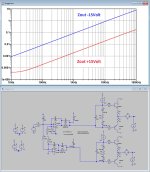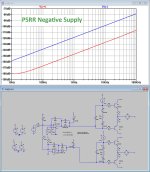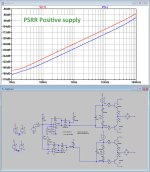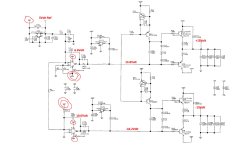Here is the simulated Zout from the +15V and the -15 outputs, but also the PSRR from the positive supply and the negative supply.
A slower LT1056 amp as the OPA2604 was used, but trying a faster one didn't change the figures that much because of the 100pF feedback cap.
PSRR figures from both positive and negative supply are quite good.
Zout figures at low frequencies are also very good, but looking at Zout for the -15Volt at the high end of the audio spectrum it seems to me that Mark Levinson may not have had access to LTSpice at that time.
Hans
A slower LT1056 amp as the OPA2604 was used, but trying a faster one didn't change the figures that much because of the 100pF feedback cap.
PSRR figures from both positive and negative supply are quite good.
Zout figures at low frequencies are also very good, but looking at Zout for the -15Volt at the high end of the audio spectrum it seems to me that Mark Levinson may not have had access to LTSpice at that time.
Hans
Attachments
Hans, I am a bit confused. If I 'look' into the output of the +15 (same -15) I see 2 ohms // 20 ohms. How can that give a Zout below 1.8 ohms or so?
There is no feedback from that output afaics.
Jan
There is no feedback from that output afaics.
Jan
The supplies are dual open loop integrators inside a feedback loop that feeds a discreet output buffer. The outputs also feed the supplies of the input integrators, hence moving. This is why it looks unnecessarily convoluted, as if the engineers couldn't regulate the supplies to the integrators well enough.
Last edited:
Jan, isn’t this essentially the same as in your boot-strapped unipolar regulator, where the error amplifier supply rail is inherently part of the output’s feedback circuit?
Last edited:
Due to copyright claiming shenanigans by an unknown party, Mark's original video on the preamp was taken down 🙄
Listened to my Garrard 301 feeding into the Groove SRX mkii last night. Still love this phono stage after all these years.
Best comment was towards the end of Marks page where someone described these products as serially produced prototypes. No real economies of scale from a one man operation.
Best comment was towards the end of Marks page where someone described these products as serially produced prototypes. No real economies of scale from a one man operation.
A miffed Mark was fun to watch. One thing which I didn’t realize from the original video is that the unit had been sent to him by Tom Evans’ co. itself for repair. Which, he successfully does only by his own ingenuity. There’s gratitude for you.
Definitely seems to be a cottage industry operation.Listened to my Garrard 301 feeding into the Groove SRX mkii last night. Still love this phono stage after all these years.
Best comment was towards the end of Marks page where someone described these products as serially produced prototypes. No real economies of scale from a one man operation.
Embarrassment explains why he wanted the video taken down. Not so much of a design guru if you have to outsource your repairs lol.A miffed Mark was fun to watch. One thing which I didn’t realize from the original video is that the unit had been sent to him by Tom Evans’ co. itself for repair. Which, he successfully does only by his own ingenuity. There’s gratitude for you.
Perhaps Tom thought Mark would exercise some discretion and simply repair the unit and invoice the labour and parts which he would then bill back to his customer plus maybe some additional markup? Agreed we may not be getting the full picture.
I'm sure everyone here understands they are not the target market. What gets me about all this are the comments about the items cost and being a rip off. If it is so easy then why are there not more people here selling their diy state of the art efforts on a individually produced basis to capture some of the market?
One needs to ask what is it about Tom's products that has allowed him to remain in business for such a long period of time?
Did anyone happen to read the review of his Linear A amp I posted? I'm still eagerly awaiting for someone to attempt a similar deep dive on the possible circuit inside.
Again I will ask it, can someone please point me towards a circuit for a SET amp that uses an op amp front end acting a phase splitter and gain stage to drive 4xEL84 that are connected to act as one "supertriode". I found an old Broskie article but that was for pentode operation.
Why do we do these types of cost analysis so much on electronics and not other products in our lives? Understandably it's because we are oriented towards the technical design and construction aspects. We make it easy and convenient to ignore all other parts of operating a business.
When is the last time you saw an ad for a TE product? There are none. Word of mouth and positive experiences with the product created Tom's success. The retail pricing is a reflection of his perceived position in the market when evaluating a product largely on subjective performance. No need to take argument with how the industry and hobbyists as a whole go about that subjective test methodology. The product is priced to what the market will bear compared to offerings at similar price points. The success of Tom Evans is that as a one man operation he can have a healthy or even excessive margin on his products yet still outperform another company much larger who is more embedded in the surrounding lifestyle of the industry ie trade shows, large dealer networks, print and online ads etc.
The opportunity is there for any of the intrepid designers here who kindly share their work in the public domain to go private a take a piece of the pie. I simply ask have you seriously considered it? What stopped you from pursuing such a venture?
I'm sure everyone here understands they are not the target market. What gets me about all this are the comments about the items cost and being a rip off. If it is so easy then why are there not more people here selling their diy state of the art efforts on a individually produced basis to capture some of the market?
One needs to ask what is it about Tom's products that has allowed him to remain in business for such a long period of time?
Did anyone happen to read the review of his Linear A amp I posted? I'm still eagerly awaiting for someone to attempt a similar deep dive on the possible circuit inside.
Again I will ask it, can someone please point me towards a circuit for a SET amp that uses an op amp front end acting a phase splitter and gain stage to drive 4xEL84 that are connected to act as one "supertriode". I found an old Broskie article but that was for pentode operation.
Why do we do these types of cost analysis so much on electronics and not other products in our lives? Understandably it's because we are oriented towards the technical design and construction aspects. We make it easy and convenient to ignore all other parts of operating a business.
When is the last time you saw an ad for a TE product? There are none. Word of mouth and positive experiences with the product created Tom's success. The retail pricing is a reflection of his perceived position in the market when evaluating a product largely on subjective performance. No need to take argument with how the industry and hobbyists as a whole go about that subjective test methodology. The product is priced to what the market will bear compared to offerings at similar price points. The success of Tom Evans is that as a one man operation he can have a healthy or even excessive margin on his products yet still outperform another company much larger who is more embedded in the surrounding lifestyle of the industry ie trade shows, large dealer networks, print and online ads etc.
The opportunity is there for any of the intrepid designers here who kindly share their work in the public domain to go private a take a piece of the pie. I simply ask have you seriously considered it? What stopped you from pursuing such a venture?
Pure narcissism. Good job Mark.One thing which I didn’t realize from the original video is that the unit had been sent to him by Tom Evans’ co. itself for repair.
God man the price is to what the market will bear.more like what ifiot audiofiles will get sucked into paying. Mr mark on u tube has an update on mr evans and his questionable marketing practice.
It is very sad to see Mark and his wonderful youTube channel attacked in such a cowardly way. Tom Evans has become another bully. He has no measured performance published, so he has a business founded on claims of amazing performance that is always better than the previous model. It is a house of cards. I guess he needs to design and sell a power conditioner and a whole room Faraday cage next to take the mythical and undocumented performance of "the groove" to twice the current level! Whatever that is. No serious HIFI lover would care. The amusing part comes when you actually drop a stylus on a record and the SNR is only 50 dB, the distortion is 0.5% at best and any cheap preamp will preserve that level of fidelity.
It would sure be great if one of the Evans fanboys on here would step up and actually measure and present the performance of this thing so we can see exactly what makes it so special. We already have pages of flowery poetry from reviewers.
It would sure be great if one of the Evans fanboys on here would step up and actually measure and present the performance of this thing so we can see exactly what makes it so special. We already have pages of flowery poetry from reviewers.
Last edited:
- Status
- Not open for further replies.
- Home
- Member Areas
- The Lounge
- The £25,000 preamp that went wrong - Tom Evans Mastergroove



